Like every other street downtown, the Houston Street of today bears little resemblance to the Houston Street of yesterday. Rows of one- and two-story wooden commercial buildings and wooden homes and boarding houses have yielded to tall concrete and steel commercial buildings and asphalt parking lots.
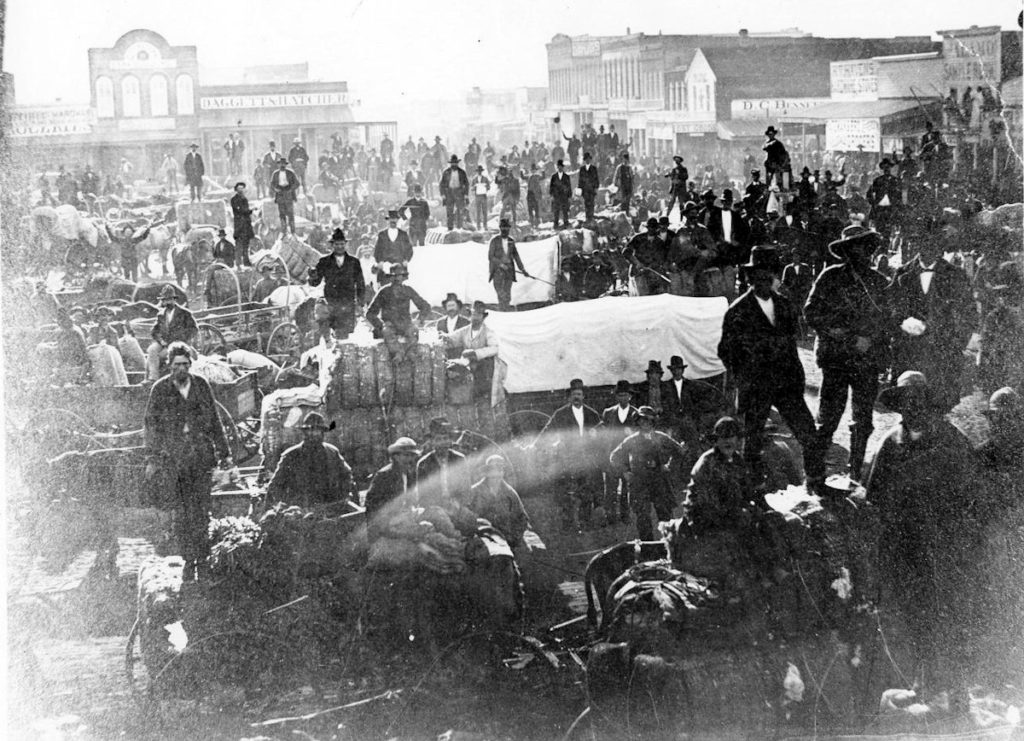
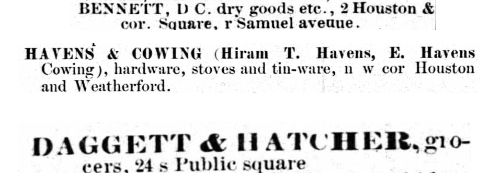 The photo above shows Houston Street at the courthouse public square on a market day in 1877. By 1877 a few buildings were brick; most were still wooden. Among the legible signage of buildings on Houston Street were those of David Chapman Bennett’s dry goods store and Hiram Havens’s hardware store. Two doors to the right of Havens was the Alamo Sample Room (offering “pure handmade sourmash whisky”). The Alamo was located about where the original Leonard’s Department Store would be built. Bennett also was a vice president of Martin Bottom Loyd’s First National Bank. Bennett’s 1870s house still stands on Samuels Avenue. Across from Houston Street, fronting on Weatherford Street, was the grocery store of Charles Biggers Daggett and R. N. Hatcher. Daggett also operated the town’s first ferry across the river at his homestead where today’s Mount Olivet Cemetery is. (Photo from University of Texas at Arlington Library.)
The photo above shows Houston Street at the courthouse public square on a market day in 1877. By 1877 a few buildings were brick; most were still wooden. Among the legible signage of buildings on Houston Street were those of David Chapman Bennett’s dry goods store and Hiram Havens’s hardware store. Two doors to the right of Havens was the Alamo Sample Room (offering “pure handmade sourmash whisky”). The Alamo was located about where the original Leonard’s Department Store would be built. Bennett also was a vice president of Martin Bottom Loyd’s First National Bank. Bennett’s 1870s house still stands on Samuels Avenue. Across from Houston Street, fronting on Weatherford Street, was the grocery store of Charles Biggers Daggett and R. N. Hatcher. Daggett also operated the town’s first ferry across the river at his homestead where today’s Mount Olivet Cemetery is. (Photo from University of Texas at Arlington Library.)
All of those buildings of 1877 are long gone, of course. But a few buildings from the early twentieth century remain, making the first ten blocks of Houston Street (from the courthouse to the convention center) a veritable Memory Lane of yoostabes.
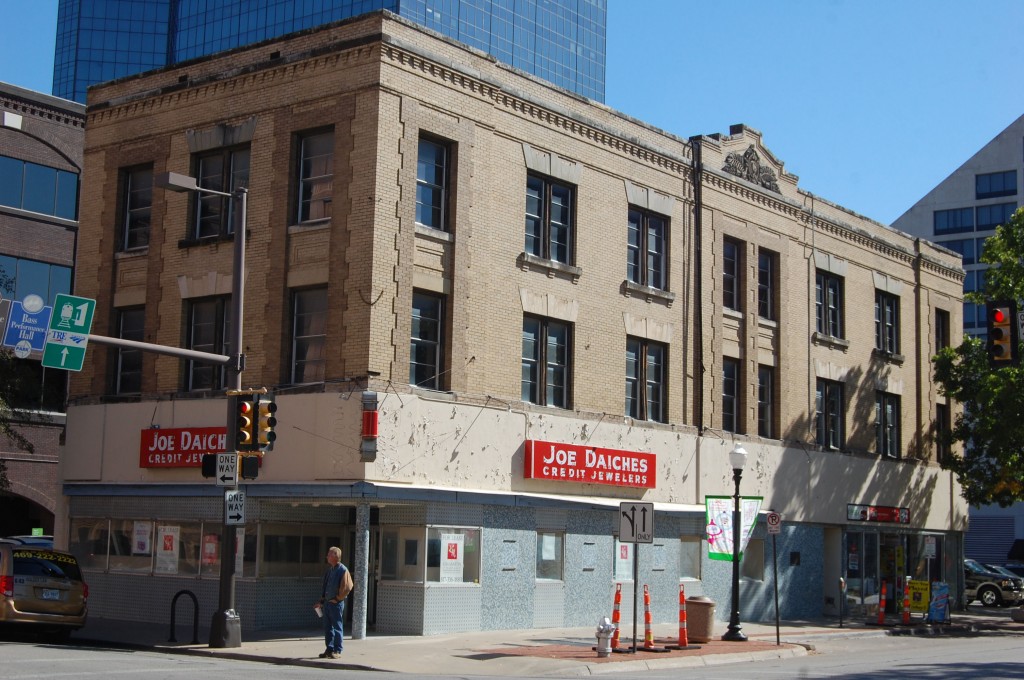 101-107 Houston (1910). For example, this building, being located on the southwestern corner of the public square (where Daggett & Hatcher had been), has had a long and rich life in retail. It yoostabe a meat market, a hotel, a hardware store, a tailor shop, a clothing store.
101-107 Houston (1910). For example, this building, being located on the southwestern corner of the public square (where Daggett & Hatcher had been), has had a long and rich life in retail. It yoostabe a meat market, a hotel, a hardware store, a tailor shop, a clothing store.
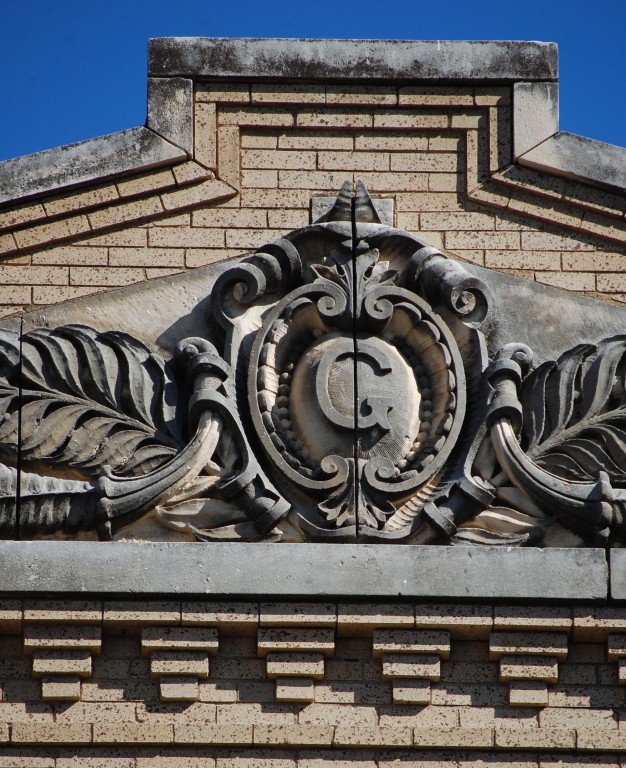 Note the letter G in the center of the parapet. Pioneer undertaker George L. Gause built the building.
Note the letter G in the center of the parapet. Pioneer undertaker George L. Gause built the building.
 From the 1912 city directory.
From the 1912 city directory.
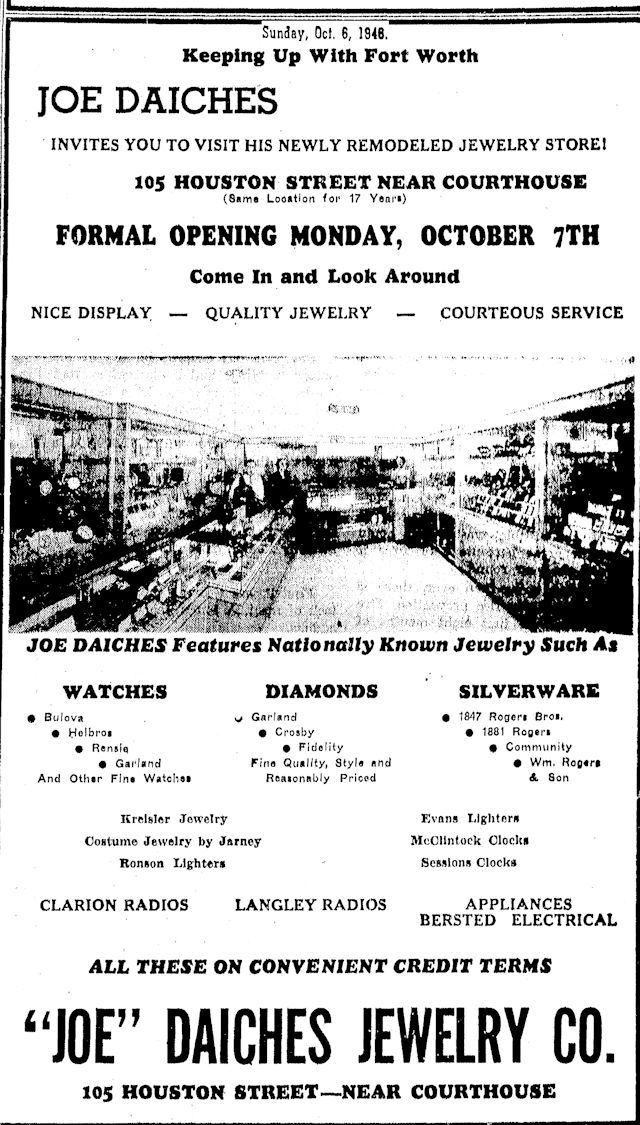 Joe Daiches was a tenant from 1929 to 2010.
Joe Daiches was a tenant from 1929 to 2010.
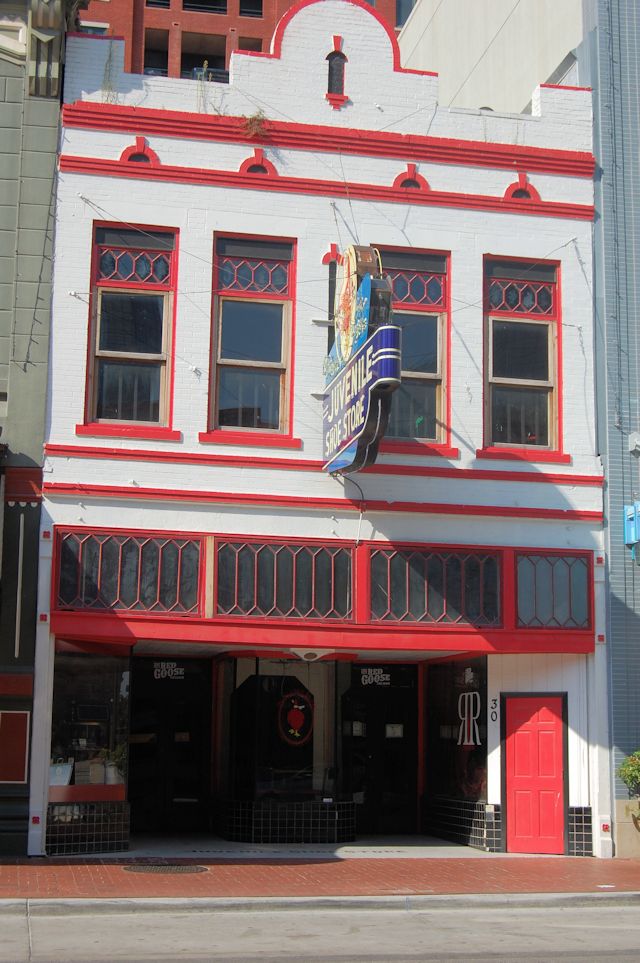 306 Houston (1903). This little building originally housed a furniture store.
306 Houston (1903). This little building originally housed a furniture store.
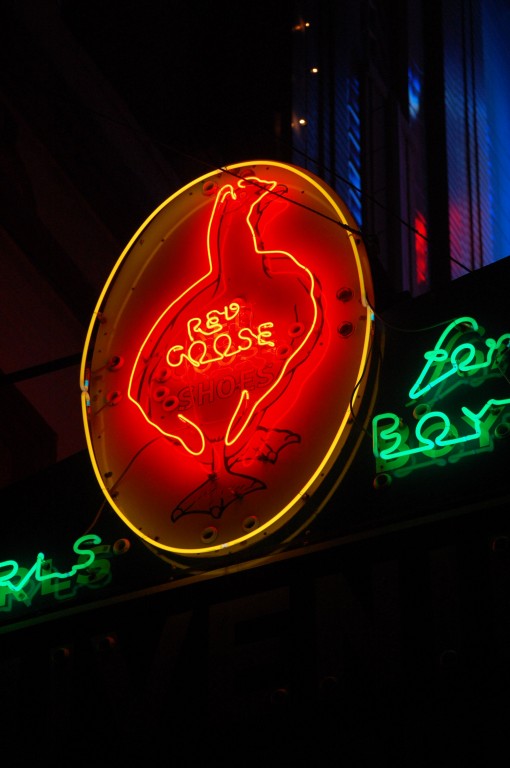 But for years beginning in the 1930s this building yoostabe Julian Solomon’s Juvenile Shoe Store with its iconic Red Goose Shoe sign.
But for years beginning in the 1930s this building yoostabe Julian Solomon’s Juvenile Shoe Store with its iconic Red Goose Shoe sign.

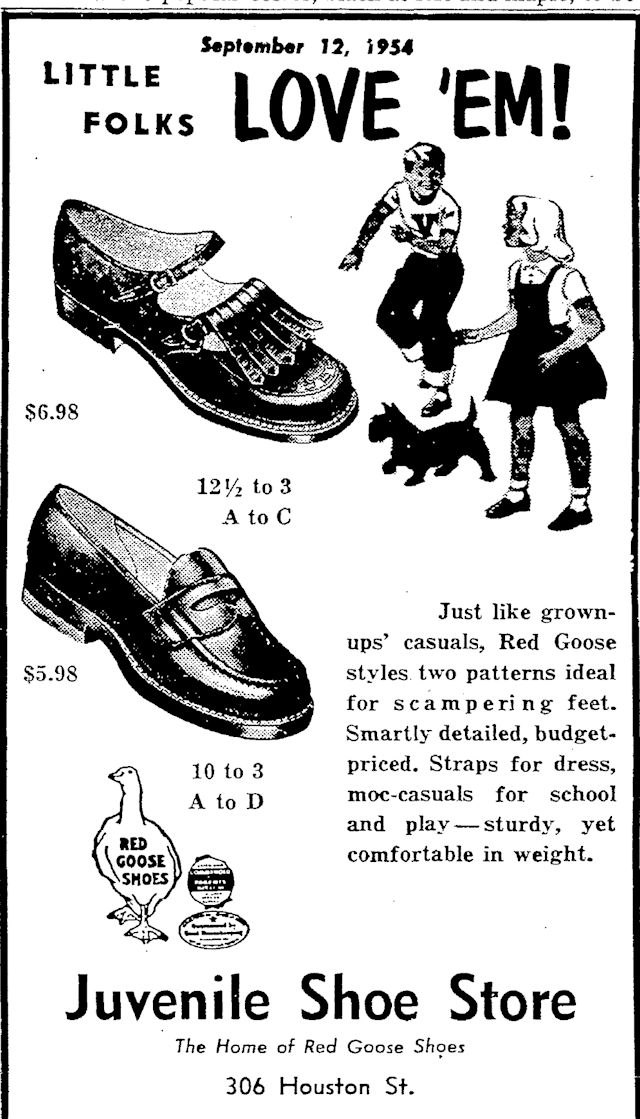
The Red Goose Saloon now occupies the building.
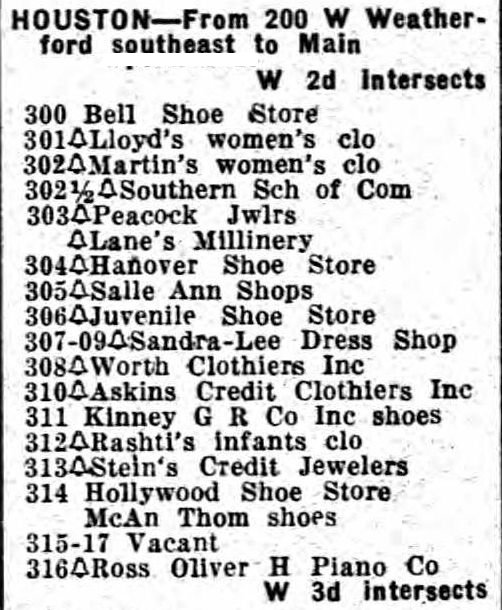 In the mid-twentieth century downtown was a bazaar: cafes, cigar stands, shoe repair shops, photo studios, train ticket outlets, and drug, jewelry, luggage, shoe, and clothing stores. In 1946 the 300 block of Houston Street had five shoe stores and eight clothing/hat stores.
In the mid-twentieth century downtown was a bazaar: cafes, cigar stands, shoe repair shops, photo studios, train ticket outlets, and drug, jewelry, luggage, shoe, and clothing stores. In 1946 the 300 block of Houston Street had five shoe stores and eight clothing/hat stores.
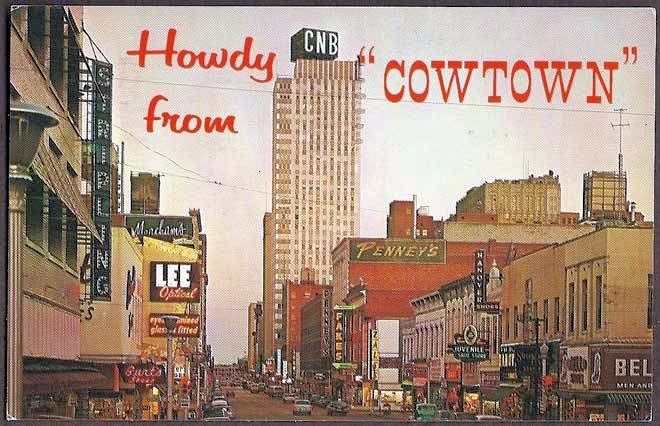 This postcard shows, looking south from West 2nd Street, on the left, Stripling and Meacham department stores; on the right, Bell Shoe Store, Hanover Shoe Store, Juvenile Shoe Store, Fakes, Penney’s.
This postcard shows, looking south from West 2nd Street, on the left, Stripling and Meacham department stores; on the right, Bell Shoe Store, Hanover Shoe Store, Juvenile Shoe Store, Fakes, Penney’s.
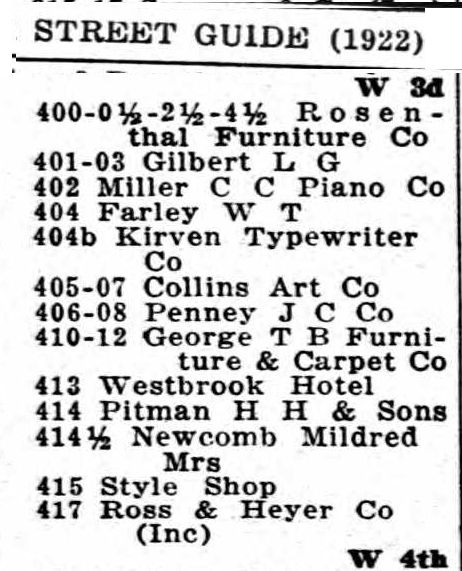
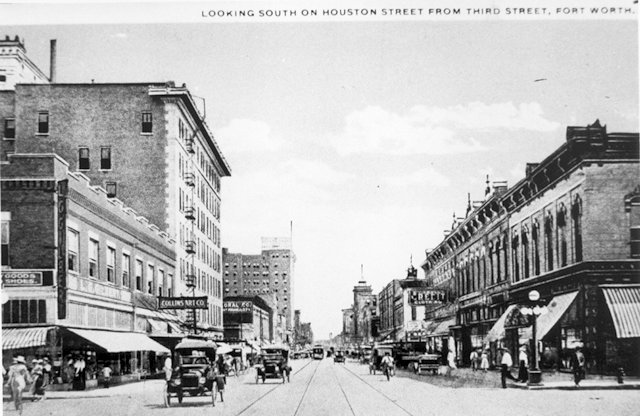
Looking south from West 3rd Street about 1920, the Westbrook Hotel on the left; Rosenthal furniture on the right. In 1922 the 400 block of Houston Street had keys aplenty: a piano store next to a typewriter store. (Photo from Tarrant County College NE, Heritage Room.)
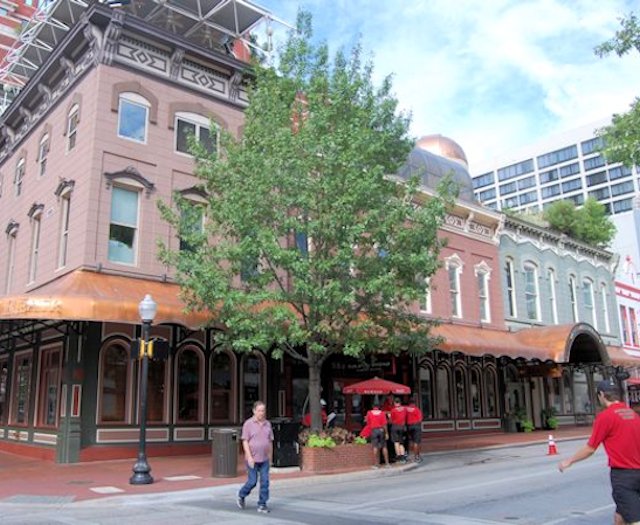 The building at 310 Houston Street has a separate post.
The building at 310 Houston Street has a separate post.
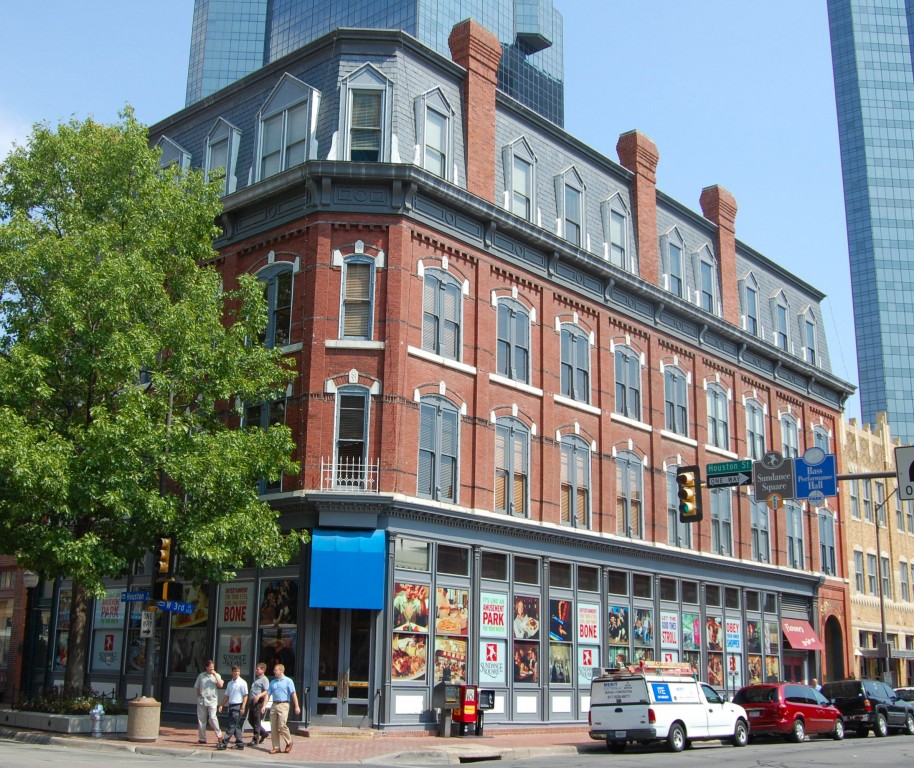 315 Houston (1885). This building, originally City National Bank, and the Jarvis Building (1884) on Main Street are perhaps the oldest commercial buildings in town.
315 Houston (1885). This building, originally City National Bank, and the Jarvis Building (1884) on Main Street are perhaps the oldest commercial buildings in town.
 Architects Sanguinet and Haggart, who also designed the Land Title Block Building, designed City National Bank Building. The bank folded in 1895. From 1983 until 2010 the building yoostabe Billy Miner’s Saloon. The Loft women’s clothing store occupies the bank building.
Architects Sanguinet and Haggart, who also designed the Land Title Block Building, designed City National Bank Building. The bank folded in 1895. From 1983 until 2010 the building yoostabe Billy Miner’s Saloon. The Loft women’s clothing store occupies the bank building.
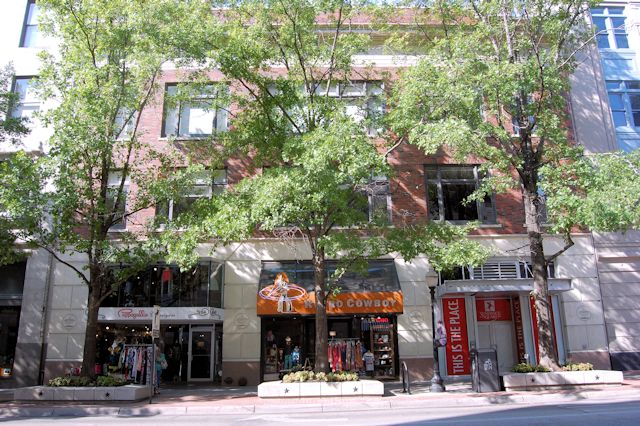 406-408 Houston (1929). This building yoostabe a J. C. Penney store until 1946. Fakes Furniture occupied the building for the next twenty years. The building is now retail and lofts.
406-408 Houston (1929). This building yoostabe a J. C. Penney store until 1946. Fakes Furniture occupied the building for the next twenty years. The building is now retail and lofts.
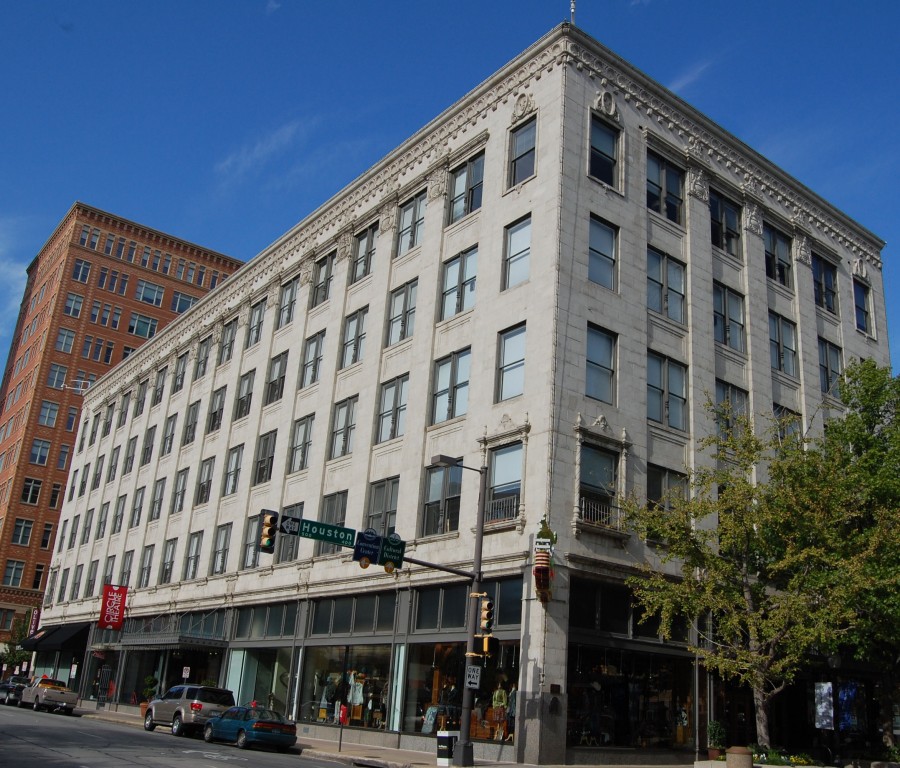 410 Houston (1929). Wyatt C. Hedrick designed this building for Sanger Brothers Department Store, which moved to this building from its building at 515 Houston.
410 Houston (1929). Wyatt C. Hedrick designed this building for Sanger Brothers Department Store, which moved to this building from its building at 515 Houston.
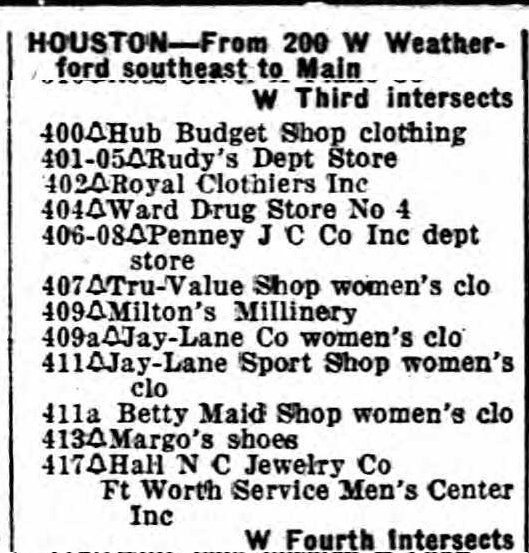 According to Tarrant County Historic Resources Survey, from 1943 to the end of World War II the Sanger Building served as the biggest USO in the country. In 1945 the 400 block of Houston contained seven clothing/hat stores, two department stores, and yet another shoe store. (In the city directory, “Ft Worth Service Men’s Center” was the USO.)
According to Tarrant County Historic Resources Survey, from 1943 to the end of World War II the Sanger Building served as the biggest USO in the country. In 1945 the 400 block of Houston contained seven clothing/hat stores, two department stores, and yet another shoe store. (In the city directory, “Ft Worth Service Men’s Center” was the USO.)
After the war J. C. Penney moved from 406-408 Houston next door and occupied the former Sanger’s location until the 1970s. The building now houses shops, apartments, and Circle Theater.
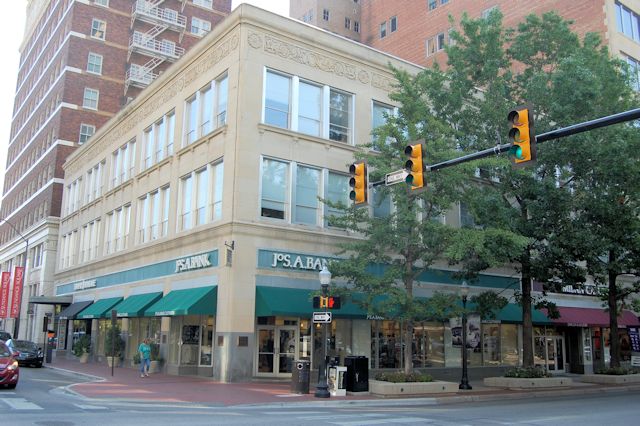 501 Houston (1926). Wiley G. Clarkson designed this building for F. W. Woolworth Department Store, which operated until 1990. Jos. A. Bank Clothier and Milan Gallery are among occupants today.
501 Houston (1926). Wiley G. Clarkson designed this building for F. W. Woolworth Department Store, which operated until 1990. Jos. A. Bank Clothier and Milan Gallery are among occupants today.
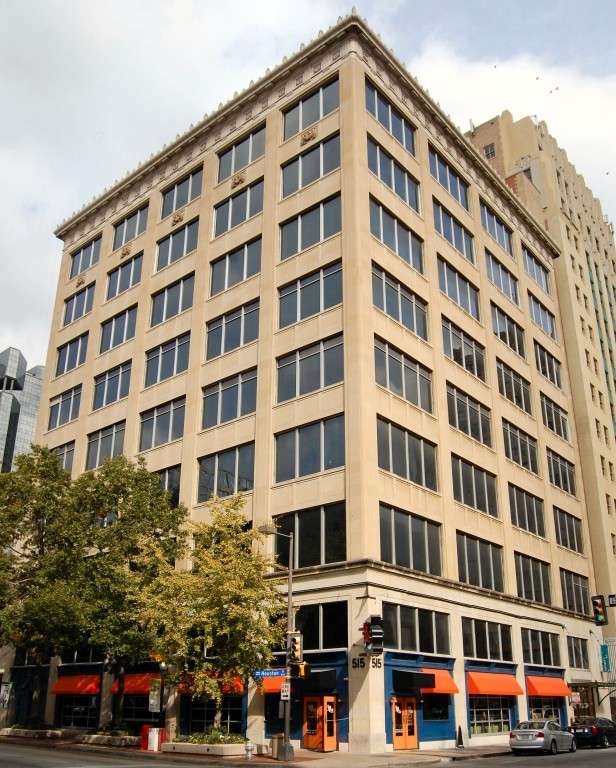 515 Houston (1925). Another Clarkson. He designed the building for Sanger’s, which occupied the building for only four years before moving to 410 Houston. From 1947 until 1971 the building housed the department store founded by Mayor Henry C. Meacham. The building also was known as the “Transportation Building” because it housed offices of the Rock Island and Frisco railroads.
515 Houston (1925). Another Clarkson. He designed the building for Sanger’s, which occupied the building for only four years before moving to 410 Houston. From 1947 until 1971 the building housed the department store founded by Mayor Henry C. Meacham. The building also was known as the “Transportation Building” because it housed offices of the Rock Island and Frisco railroads.
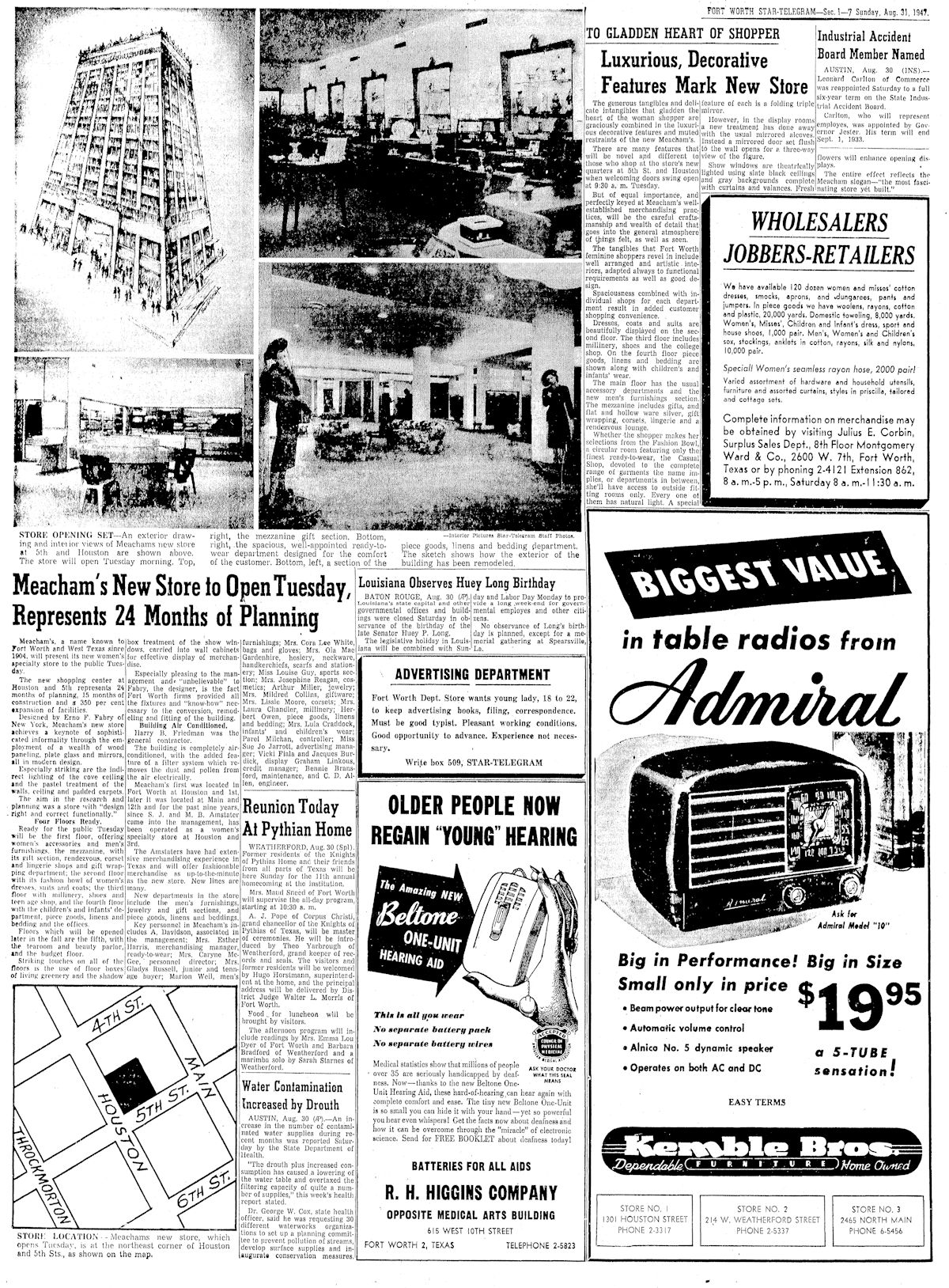 In 1947 Meacham’s Department Store moved from its building on Houston at West 3rd Street into the old Sanger’s building. Meacham’s had opened in Fort Worth in 1904. The store’s slogan was “the most fascinating store yet built.”
In 1947 Meacham’s Department Store moved from its building on Houston at West 3rd Street into the old Sanger’s building. Meacham’s had opened in Fort Worth in 1904. The store’s slogan was “the most fascinating store yet built.”
 In 1946 the east side of the 500 block had three department stores: Woolworth, Monnig’s, and Meacham’s.
In 1946 the east side of the 500 block had three department stores: Woolworth, Monnig’s, and Meacham’s.
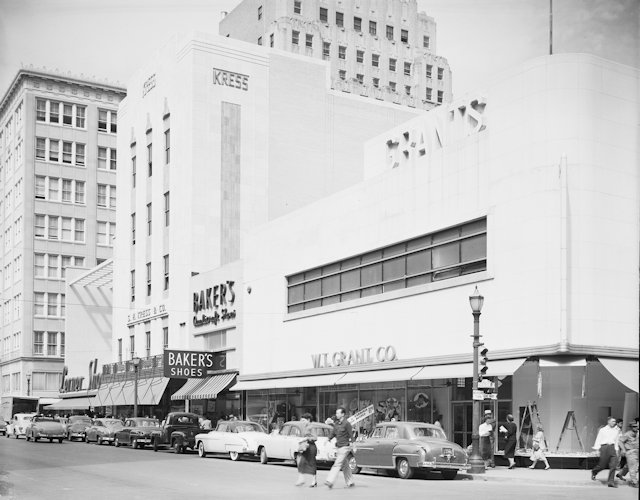 605, 609, 613 Houston in 1951. (Photo from University of Texas at Arlington Library.)
605, 609, 613 Houston in 1951. (Photo from University of Texas at Arlington Library.)
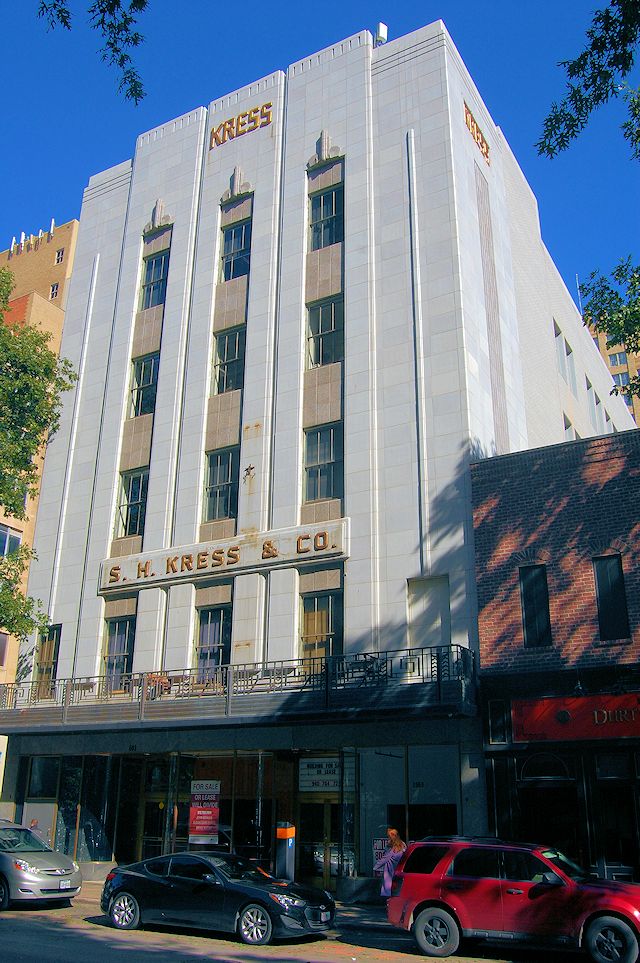
605 Houston (1936). The Kress Building, which had entrances on both Houston and Main streets, has a separate post. The building is now apartments.
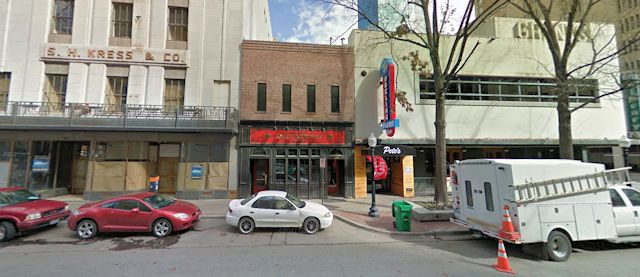 609 Houston. The small building next to Kress was built in 1905.
609 Houston. The small building next to Kress was built in 1905.
 It yoostabe Pangburn’s Chocolate Shop.
It yoostabe Pangburn’s Chocolate Shop.
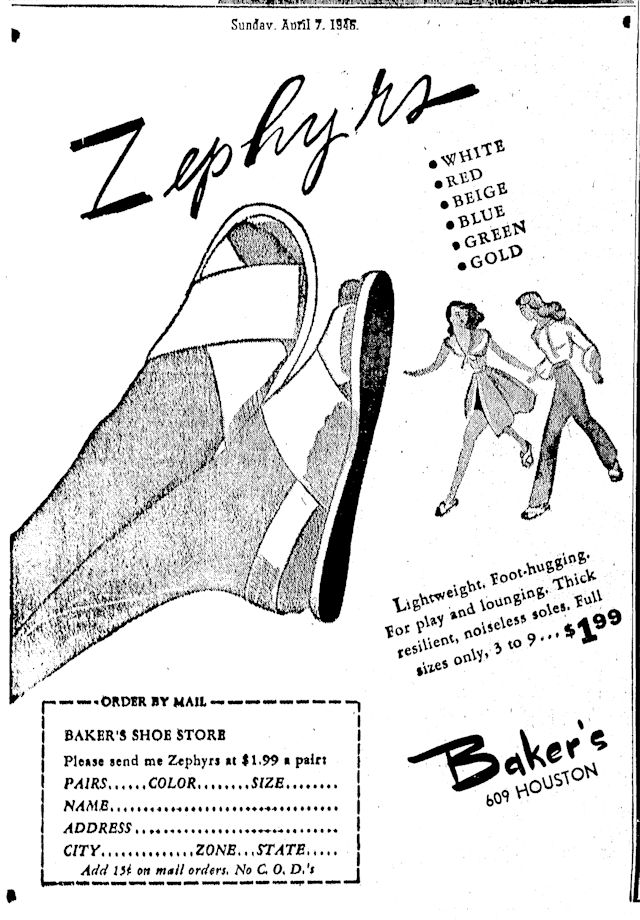 The building was remodeled in 1934 to house Baker’s shoe store. It later housed Goldstein Brothers. Today it houses Durty Murphy’s.
The building was remodeled in 1934 to house Baker’s shoe store. It later housed Goldstein Brothers. Today it houses Durty Murphy’s.

 613 Houston (1939). The dime stores of William Thomas Grant of Massachusetts operated from 1906 until 1976. The building now houses two bars.
613 Houston (1939). The dime stores of William Thomas Grant of Massachusetts operated from 1906 until 1976. The building now houses two bars.
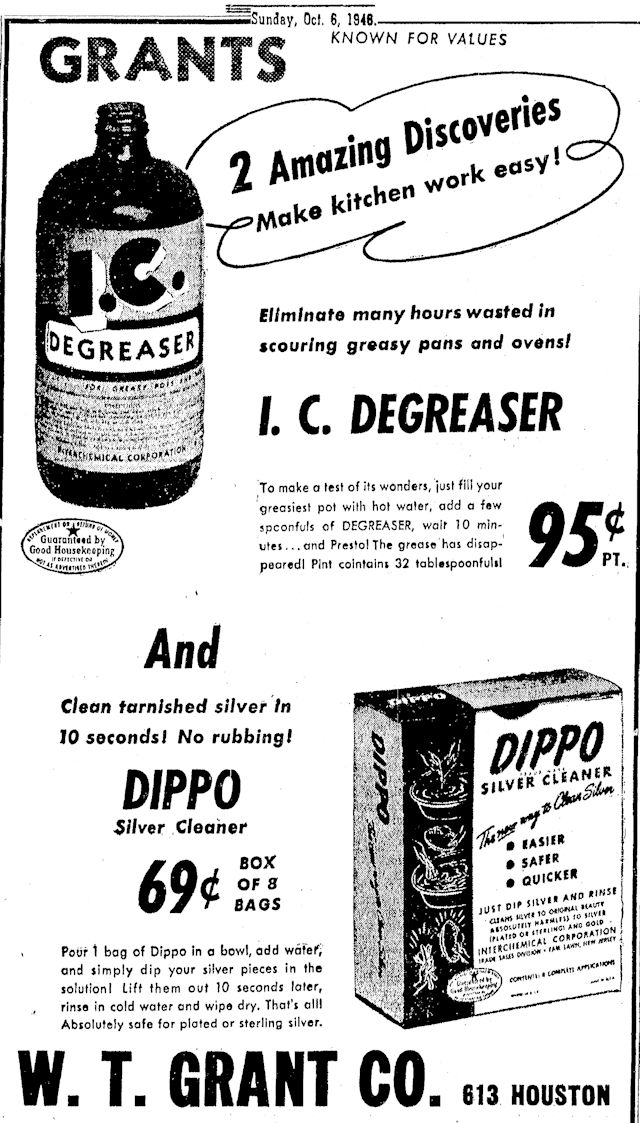
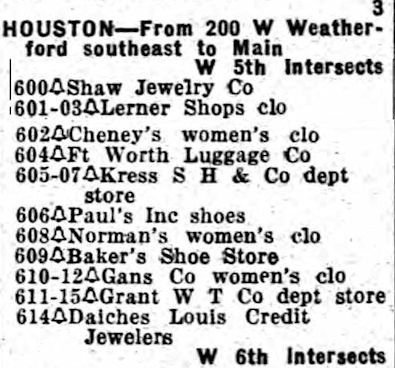 In 1946 the 600 block contained four clothing stores, two jewelers, two department stores, and two more shoe stores.
In 1946 the 600 block contained four clothing stores, two jewelers, two department stores, and two more shoe stores.
 711 Houston (1910). Sanguinet and Staats designed the original building, which was only fifty feet wide, as the new home of First National Bank. At eleven stories in 1910 it was considered downright vertiginous. In 1926 Wyatt C. Hedrick designed an addition that doubled the building’s facade along Houston Street. In 2003 XTO Energy, headed by Bob Simpson, bought the building. The building was restored and in 2005 renamed the “Bob R. Simpson Building.”
711 Houston (1910). Sanguinet and Staats designed the original building, which was only fifty feet wide, as the new home of First National Bank. At eleven stories in 1910 it was considered downright vertiginous. In 1926 Wyatt C. Hedrick designed an addition that doubled the building’s facade along Houston Street. In 2003 XTO Energy, headed by Bob Simpson, bought the building. The building was restored and in 2005 renamed the “Bob R. Simpson Building.”
 900 Houston (1910). This building yoostabe a hotel, pharmacy, clothing store, and A&P grocery store.
900 Houston (1910). This building yoostabe a hotel, pharmacy, clothing store, and A&P grocery store.
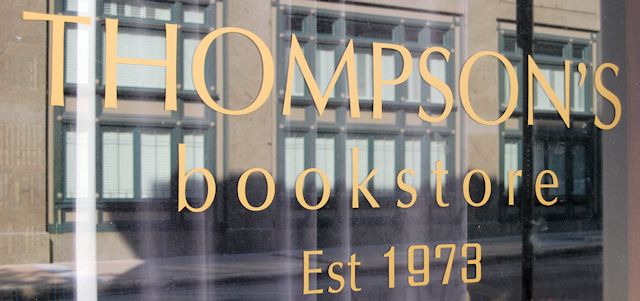 And, of course, Thompson’s Bookstore occupied the building for several years beginning in 1973.
And, of course, Thompson’s Bookstore occupied the building for several years beginning in 1973.
 A bar by the same name is the current occupant.
A bar by the same name is the current occupant.
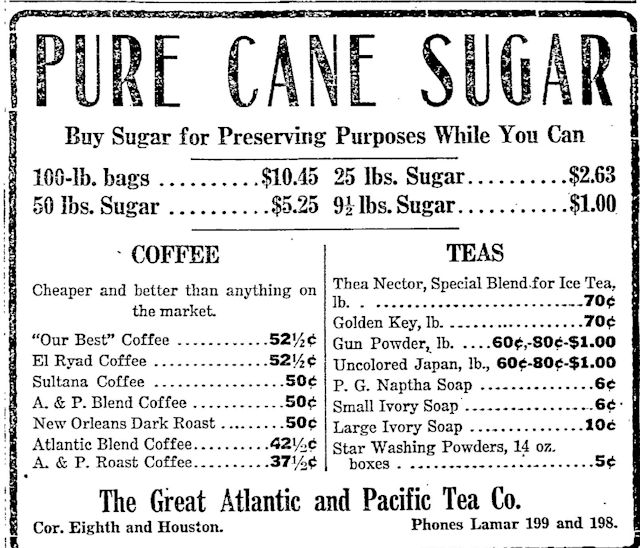 In 1919 you could treat your sweet tooth to a hundred-pound bag of sugar at that A&P for $10.45.
In 1919 you could treat your sweet tooth to a hundred-pound bag of sugar at that A&P for $10.45.
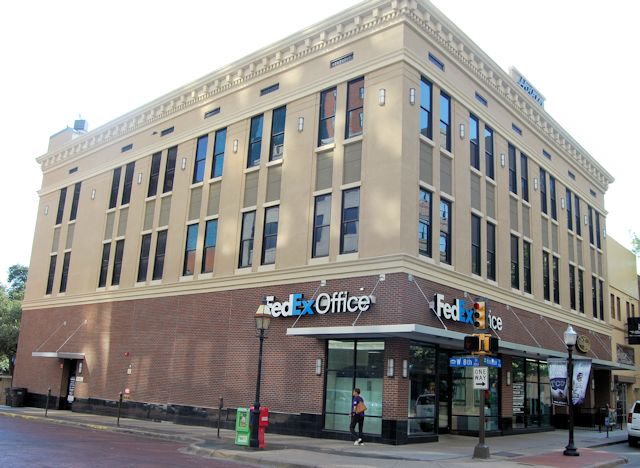 901 Houston (1900). This old building has been expanded and remodeled several times in its long retail life. Owner John Shelton added a third floor in 1910 and in 1911 leased the building to the S. H. Kress Company. In 1936 Kress built a larger building on Main Street (see above). In 1937 901 Houston housed another dime store: McCrory’s. Later it housed Hogan’s office supply. Today it houses a FedEx Office Print & Ship Center.
901 Houston (1900). This old building has been expanded and remodeled several times in its long retail life. Owner John Shelton added a third floor in 1910 and in 1911 leased the building to the S. H. Kress Company. In 1936 Kress built a larger building on Main Street (see above). In 1937 901 Houston housed another dime store: McCrory’s. Later it housed Hogan’s office supply. Today it houses a FedEx Office Print & Ship Center.
 The 1920 city directory lists A&P and Kress in the 900 block.
The 1920 city directory lists A&P and Kress in the 900 block.
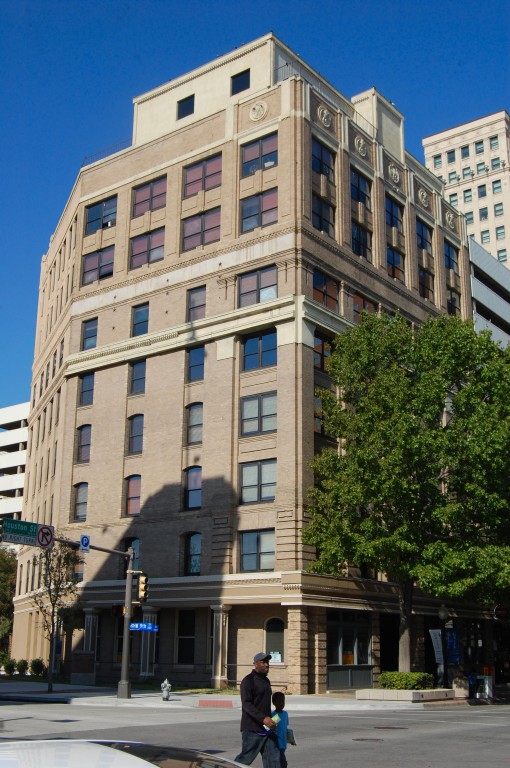 910 Houston (1906). Another Sanguinet and Staats, one of the first concrete skyscrapers in Fort Worth with five sides and—to begin with—a dizzying six stories.
910 Houston (1906). Another Sanguinet and Staats, one of the first concrete skyscrapers in Fort Worth with five sides and—to begin with—a dizzying six stories.
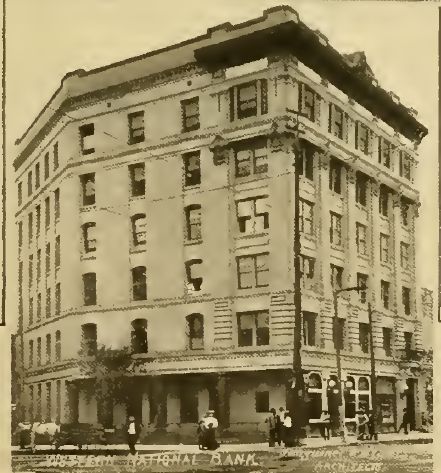 This photo shows the building when it had just six stories.
This photo shows the building when it had just six stories.
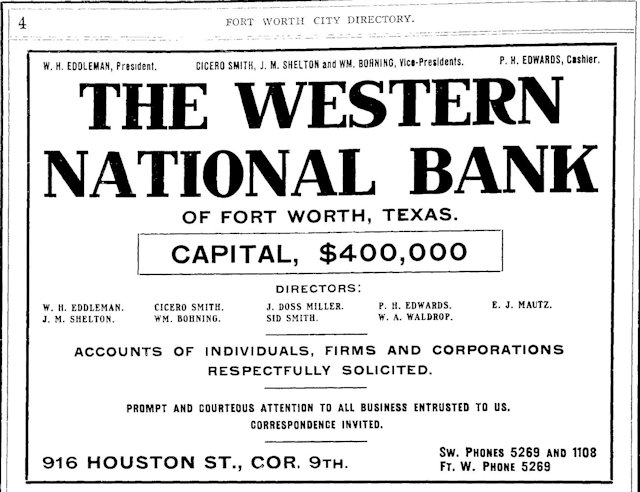 The building began its career as the home of William H. Eddleman’s Western National Bank.
The building began its career as the home of William H. Eddleman’s Western National Bank.
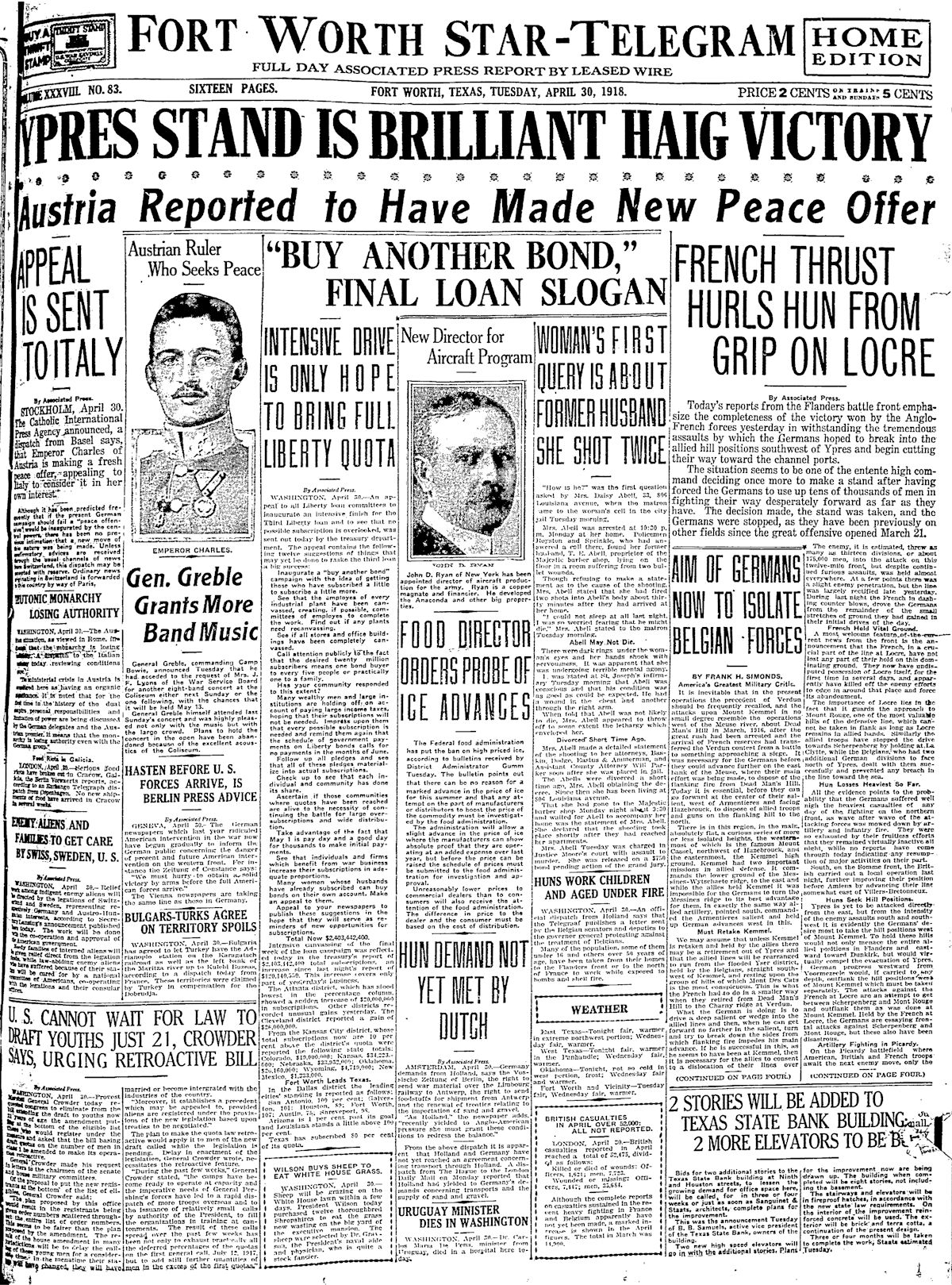 By 1918 the building housed Texas State Bank, which on April 30, on a front page dominated by news of the war, announced that two stories, designed by Sanguinet and Staats, would be added to the building. The building now houses condos.
By 1918 the building housed Texas State Bank, which on April 30, on a front page dominated by news of the war, announced that two stories, designed by Sanguinet and Staats, would be added to the building. The building now houses condos.
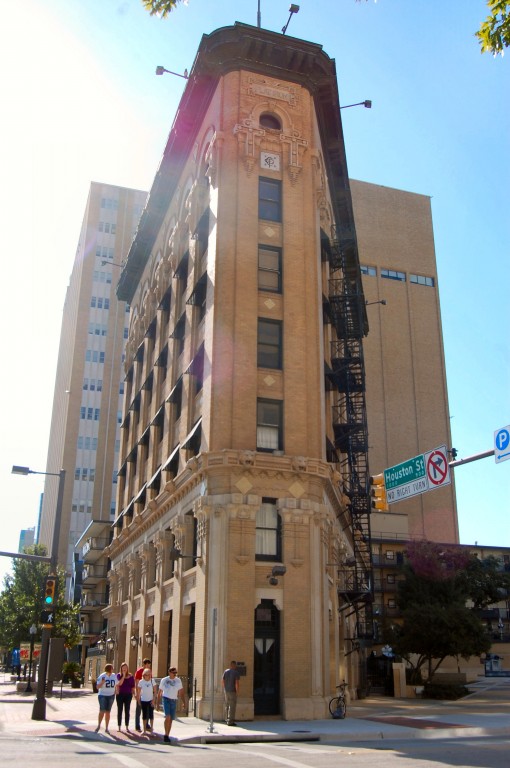 1000 Houston (1907). Just across West 9th Street, Sanguinet and Staats designed the iconic little Flatiron Building for Dr. Bacon Saunders, dean of Fort Worth University’s Fort Worth Medical College. The steel-framed building, one of the tallest in town at the time, was inspired by Manhattan’s Flatiron Building (1902). The Fort Worth building has been renovated by owner Dr. George Cravens.
1000 Houston (1907). Just across West 9th Street, Sanguinet and Staats designed the iconic little Flatiron Building for Dr. Bacon Saunders, dean of Fort Worth University’s Fort Worth Medical College. The steel-framed building, one of the tallest in town at the time, was inspired by Manhattan’s Flatiron Building (1902). The Fort Worth building has been renovated by owner Dr. George Cravens.
Pause a New York minute to think about this: Our Flatiron Building is one block from Worth Square, named for city namesake General William Jenkins Worth. The general is buried in Worth Square in Manhattan one block from that Flatiron Building.
The Western National Bank and the Flatiron buildings were built when the swastika was a popular symbol of good luck. Both buildings feature the symbol on their exterior.
 This W. D. Smith photo from Fort Worth in Pictures gives us a 1940 snapshot of the west side of Houston Street. At 906 the bank building housed Mitchell, Gartner & Thompson Insurance Company. On the left edge are the Flatiron Building and the 1939 public library. Looming behind 906 are The Fair (left) and the Waggoner Building. The short building with the black wall is the Thompson’s Bookstore building. Behind the Waggoner Building was the Board of Trade Building (1889).
This W. D. Smith photo from Fort Worth in Pictures gives us a 1940 snapshot of the west side of Houston Street. At 906 the bank building housed Mitchell, Gartner & Thompson Insurance Company. On the left edge are the Flatiron Building and the 1939 public library. Looming behind 906 are The Fair (left) and the Waggoner Building. The short building with the black wall is the Thompson’s Bookstore building. Behind the Waggoner Building was the Board of Trade Building (1889).
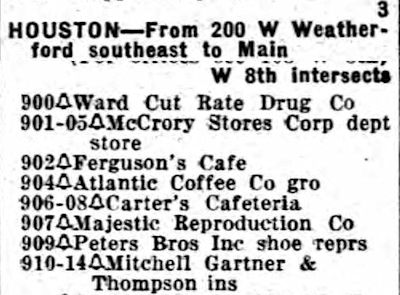 By 1946 McCrory’s was still at 901, A&P was still across Houston Street in the Thompson’s Bookstore building. The Western National/Texas State Bank Building was occupied by Mitchell, Gartner & Thompson insurance. And look at 909 Houston Street. No yoostabe there. Nosiree. That’s a genuine stillis!
By 1946 McCrory’s was still at 901, A&P was still across Houston Street in the Thompson’s Bookstore building. The Western National/Texas State Bank Building was occupied by Mitchell, Gartner & Thompson insurance. And look at 909 Houston Street. No yoostabe there. Nosiree. That’s a genuine stillis!
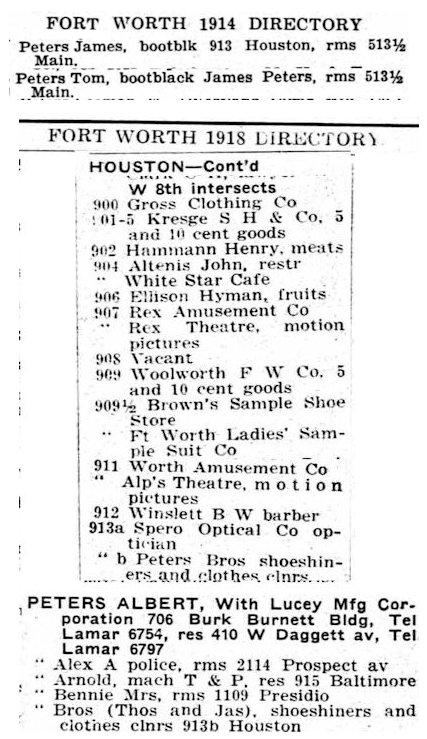
 909 Houston (1917). James and Thomas Peters owned a shoeshine parlor in Waco, moved their business to Fort Worth in 1911, and branched into repairing shoes, cleaning clothes, restoring hats, and, finally, making hats.
909 Houston (1917). James and Thomas Peters owned a shoeshine parlor in Waco, moved their business to Fort Worth in 1911, and branched into repairing shoes, cleaning clothes, restoring hats, and, finally, making hats.
Peters Bros. remains a landmark on Houston Street:
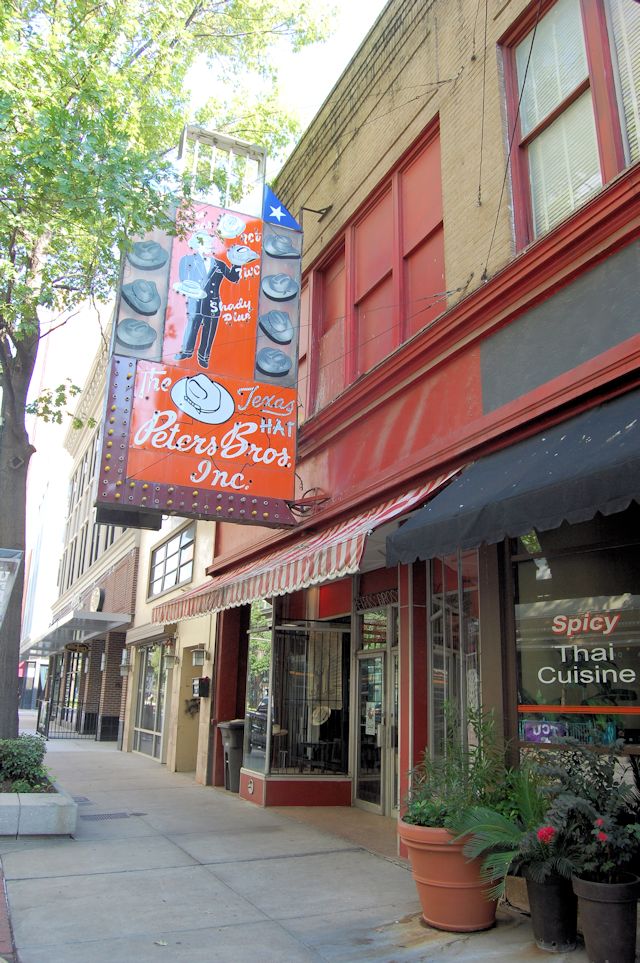
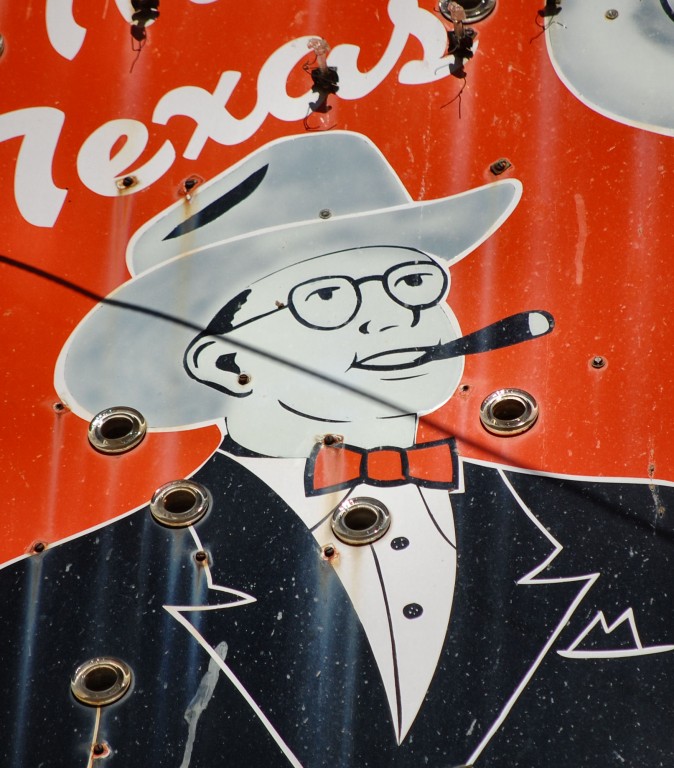 Hats off to fifteen yoostabes and one stillis.
Hats off to fifteen yoostabes and one stillis.
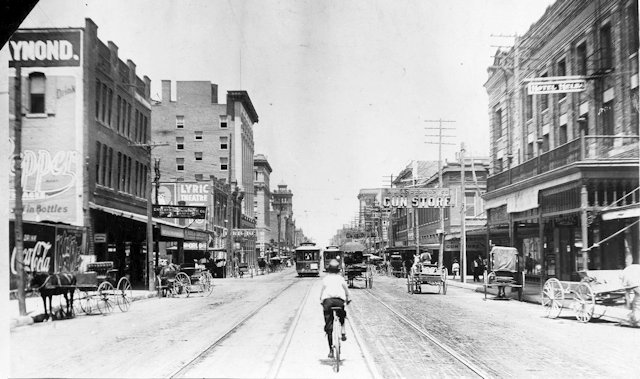 End of the Houston Street yoostabe tour. Now turn around and look back up the street from West 10th street about 1910.
End of the Houston Street yoostabe tour. Now turn around and look back up the street from West 10th street about 1910.
 Along the left side of the 1000 block of Houston Street in the 1910 photo, near to far: Raymond House rooms and Burns and Hamilton paint store, Lyric vaudeville theater, which in 1907 featured “new moving pictures” and Lorenzo the “juggling butcher” (1907; Park Central Hotel is on those sites today), Flatiron Building (1907, Sanguinet and Staats), Western National Bank Building (1906, Sanguinet and Staats), square tower of the Board of Trade Building (1889, Armstrong and Messer). Along the right side, near to far: Hotel Melba, A. J. Anderson’s gun store, and Elks European Hotel (the Convention Center is on those sites today). Only the Flatiron Building and Western National Bank Building survive.
Along the left side of the 1000 block of Houston Street in the 1910 photo, near to far: Raymond House rooms and Burns and Hamilton paint store, Lyric vaudeville theater, which in 1907 featured “new moving pictures” and Lorenzo the “juggling butcher” (1907; Park Central Hotel is on those sites today), Flatiron Building (1907, Sanguinet and Staats), Western National Bank Building (1906, Sanguinet and Staats), square tower of the Board of Trade Building (1889, Armstrong and Messer). Along the right side, near to far: Hotel Melba, A. J. Anderson’s gun store, and Elks European Hotel (the Convention Center is on those sites today). Only the Flatiron Building and Western National Bank Building survive.






… I absolutely love your virtual street by street tours of downtown Fort worth, when I find myself downtown on business (fun) I have to clock at least 3hours on the parking meter so I can do your tour in real time, well worth the parking ticket, the tour takes 5 hours…
… Happy New year…
Thanks, Scott. The tours of Main and Houston streets were two of my more ambitious projects. Got a post coming that traces the ribbon of road that begins at Henderson Street as “West 3rd Street” all the way to Mansfield Highway-twenty miles.
Seeing the 40’s listing for Lerner’s makes me sad. Glad we still have so much Deco, but we lost the ZING of mid-cent when we lost the swoop of the Lerner’s lattice and the Telstar and aqua glam of the Startlegram auxiliary.
Thanks, Sally. Downtown has changed so much. I wish I could bring Paddock or Peter Smith or even Amon Sr. back for a tour. They would die all over again.
Enjoyed reading this article on Houston St. The building at 901 Houston was remodeled in 1937 by my grandfather as an “Art Moderne” design which was “cutting edge” in 1937. The latest remodel of the building was done by the Fort Worth Architectural Firm of Hahnfeld Hoffer Stanford, Mark Travis, Project Coordinator for the project. He supplied me with photographs of the original building, and the remodeled building of 1937 which was taken not long before the project was begun.
That old building has had many a makeover and many a tenant.